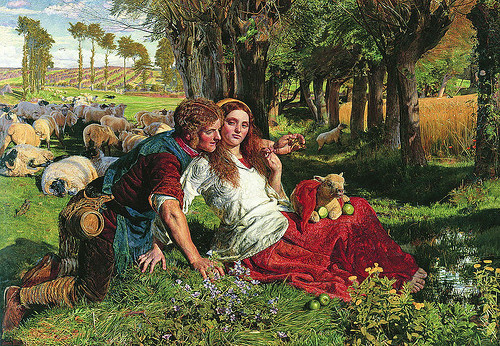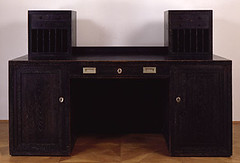Just some drivel from a PhD student in 17th century English literature. Masoret is Hebrew for tradition; Masor is also the Hebrew word for saw. Since i hope to be learning and blogging about traditional woodworking (amongst sundry other things), i thought it was an apt play on words. Before you ask, yes, i have a glamorous social life.
Wednesday 30 December 2009
Some Chinese Woodworking
Tuesday 29 December 2009
Apartment Grey Water #5 חוסכים מים בירושלים
Sunday 27 December 2009
Even Old New York Was Once New Amsterdam

Tuesday 22 December 2009
Boulle Exhibit
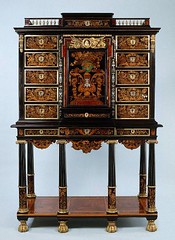
Thursday 17 December 2009
Pachelbel & Taco Bell
As i heard accompanying English lyrics in my head, the familiarity turned into shock. Could it be? Nah? That's INSANE!:
Yeah! Paul Simon totally ripped off Bach!
Before the next example, I just want to publicly apologise to my father who is probably tearing his hair out and wondering what he did wrong when his own daughter recognises this:
because she was first familiar with this:
'How burgerlijk!'
Monday 7 December 2009
A Linguistics Lesson from South Park
Monday 30 November 2009
Addendum: Thanksgiving & Flemish and Dutch New York
Sunday 29 November 2009
Dutch-American Heritage Day

Since it was Dutch American Heritage day (16 of November), I just wanted to mention a book I read recently and loved. Russell Shorto’s The Island at the Center of the World. Whenever I go to New York, I always like to hunt around for the remains of New Amsterdam. But it's always hard to find. There are a few monuments and plaques, and some passing references here and there, but i always get the feeling that the story of Dutch America has been short-changed. It makes sense, really. The Dutch do not hold dear their language like the French, nor their pomp like the English. Instead--the infamous red-light district aside--it's a culture of modesty. Everything is diminutive. For instance, glass is a glasje (small glass) and a small glass is doubly small--a kleine glasje. Culturally, the Dutch are almost apologetic, even when people (mostly Americans) have no clue where the Netherlands is or the language spoken there ('do they speak Hollish in Holland?'). I hear Dutch people always preempting this with 'it's a very small country', and other explanations. My personal experience has been the same. I remember my Dutch mother giving up and just saying 'I'm from Europe,' (rolling her eyes, sometimes) after a while. My mother was also more than happy to let the language go with us children, so most of what we know has been self-taught later on in life. My grandparents tried to intercede but not necessarily on behalf of the Dutch language--they wanted my mother to speak to us in her strongest language after Dutch--French (also to no avail)!
Russell Shorto's best-seller saves the Dutch culture of America from being let go. Besides the obvious adage that it is the victors who write history, there are other reasons for the English stranglehold on American history. Shorto humorously explains that American historians found an easier story in Puritan New England than the more rough-and-tumble reality of Dutch Manhattan.
Accounts like that of a woman who, while her husband dozed on a nearby chair, ‘dishonourably manipulated the male member’ of a certain Irishman while two other men looked on. Excessive rigidity (of the moral kind) was not the sin of New Amsterdam’s residents.’ (p. 85)
{Shorto's wit is another great feature of the book. I think the following is the best sentence i have ever come across in a book about history:
The Reverend Jonas Michaelius might well have won a contest for the moodiest, bitchiest resident of New Amsterdam (p. 64)
Phenomenal!}
The historical revisionism of American history is, bluntly put, a conscious decision of total haters with English ancestry. Think i'm being harsh? Shorto brings evidence that nineteenth-century historians considered the Dutch chapter of American history inconsequential at best. Descriptions of the
petty cheeseparing of the Batavian provinces, with their windmills and barren soil, fit only for fuel
are among the kinder references made to the Dutch in nineteenth century American historical surveys.
Shorto instead brings to life Adriaen van der Donck, a young lawyer sent to New Netherland who pushed for the Republican-style government and freedom that became so central to America's cultural heritage. Shorto draws you into his tale by beginning with the work of Charles Gehring, who has worked for over 30 years (and is still going!) translating over 12,000 folios of Dutch colonial records. This book is sweet. Shorto does not divorce New Netherland history from 17th century Dutch history (if you loved Simon Schama's page-turner on the topic you will totes dig this), enriching both in the process. There's also a lot of cool facts to learn. I had no idea that the first kosher butcher on Manhattan Island was a Polish Jew named Asser Levy who stood up to Stuvesant's anti-Semitic wrangling. Want to know who Downing Street was named after? Read the book.
Despite my enthusiasm for this book, there is a huge problem in its premise. Essentially, Shorto makes the argument that the Dutch colony had its roots in thinkers like Grotius and Spinoza; liberals who advocated civil over religious law, in contrast to the witch burning crazy English colonies. To read Grotius as freeing natural law from theology is a dangerous misreading of Grotius at best, and a gross misrepresentation at worst. What follows is the philosophy that the only tolerant society is one that divorces itself from its religious heritage, which diminishes the monumental achievement of the 'tolerant' society of 17th century New Netherland, which was, indeed rooted in theology. That's where Shorto seems to drop the ball. He has us imagining van der Donck studying law at Leiden with Grotius, (which is awesome, granted), but if anything stands out about 17th century Leiden (besides the fact that it was full of Englishman wearing buckled hats and pimp-shoes), it's that the hottest topic of study gripping the place was Hebraism. That is to say, people like Grotius, and later, Selden in England, were defining international and natural law according to rabbinic sources such as the Talmud and Maimonides. A liberal environment, certainly. A Godless one, definitely not.
Tuesday 17 November 2009
Hitgenstein: Even Before Brangelina & Bennifer
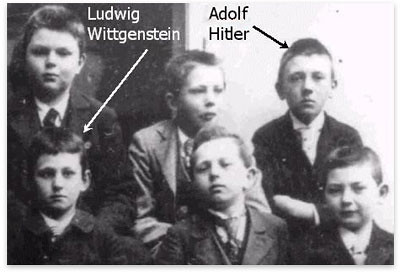
Monday 26 October 2009
A Note on Richard Hooker's Impact on Pre-Raphaelite Art
In May 1851 he [Holman Hunt] wrote to the poet Coventry Patmore, who had been responsible for enlisting Ruskin's support, asking to borrow a copy of the works of the seventeenth-century theologian Richard Hooker. He added: 'As however I am obliged to read for my next year's subjects much just now, I hope you will be able to spare it some time'. Hooker provided the theme of The Hireling Shepherd, with its underlying attack on sectarianism for deflecting the clergy from the task of tending their flock. The picture marks out a new direction, in which the symbolism is so arcane as to be virtually impenetrable without a literary gloss. The painting can, however, be enjoyed on many levels. Its sunlit landscape, with its closely observed blue shadows, was painted at Ewell, Surrey, between June and December 1851 and was Hunt's most ambitious attempt at naturalism to date.
His dislike of narrow sectarianism-which underlies the composition of The Hireling Shepherd and Our English Coasts, 1852-deepened into disgust on his first visit to Jerusalem, where he found squabbling Christian sects vying with each other to convert the poverty-stricken Jews. Bribery was endemic and Hunt was so incensed by the activities of Samuel Gobat, Anglican bishop of Jerusalem, in this respect that in 1858 he published a pamphlet unmasking him (ODNB).
Friday 23 October 2009
A Wittgenstein Wochenendbeilage
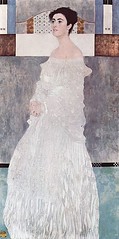
 In 1925, Margaret Stonborough also commissioned her brother Ludwig--then a gardener in a nearby monastery--as an architect to design a large house for her in Vienna. Wittgenstein worked alongside Paul Engelmann, his friend from the army. Just to get an idea of how all the modernist movements are intertwined (not necessarily harmoniously), Engelmann had studied under Adolf Loos, who was also a friend of Wittgenstein. Loos basically bashed the Vienna Secession, whose building Wittgenstein's father had financed.
In 1925, Margaret Stonborough also commissioned her brother Ludwig--then a gardener in a nearby monastery--as an architect to design a large house for her in Vienna. Wittgenstein worked alongside Paul Engelmann, his friend from the army. Just to get an idea of how all the modernist movements are intertwined (not necessarily harmoniously), Engelmann had studied under Adolf Loos, who was also a friend of Wittgenstein. Loos basically bashed the Vienna Secession, whose building Wittgenstein's father had financed. Addendum:
I got a helpful comment from a reader on Lumberjocks (where i also post my blog), as well as some suggested reading. I thought i would post it here so we can all benefit. Thanks, JL Smith!
As a result of my education (both formal and informal) I have a pretty good grasp of the Vienna Secession particularly from an architectural and painting perspective. I have always found it interesting that the movement imposed no aesthetic dogma but instead focused on producing modern works of art. My understanding of the context beyond the artistic world has always been somewhat limited. I am sure you know that Art and Architectural history professors typically don’t like to teach social and political history. For the most part it seems if one whats to understand the art world in it’s broader context they will have to do it on their own.
I don’t know if these reading suggestions will align with your interests or not but I have read them and found them interesting. They cast a wider net then most art/architectural books do regarding context (the widest context is probably the Judgment of Paris).
These three are by Ross King
The Judgment of Paris: The Revolutionary Decade that Gave the World Impressionism
Michelangelo and the Pope's Ceiling
Brunelleschi's Dome: How a Renaissance Genius Reinvented Architecture
Gregory Curtis wrote
The Cave Painters: Probing the Mysteries of the World's First Artists
Philip Steadman wrote
Vermeer's Camera: Uncovering the Truth behind the Masterpieces
Thursday 15 October 2009
The Debate of the Carpenter's Tools
1 Shype-Ax. Most likely an ax used for chipping or trimming. See MED, “chip-ax.”
3 Clene hose and clene schone. The sense of these lines appears to be “I will earn you food and drink, but you’ll have to work harder to earn yourself clothing.”
6 Thall. “Thou will.” See MED, “thou.”
7 longys the crafte. Crafte may here refer to the profession of carpenters in general, or the local craft guild of carpenters more specifically.
9 Belte. An “allet maul, hammer; also, a bat or club.” See MED, “betel.”
13 Twybyll. A “kind of ax with two cutting edges; formerly used for cutting mor tices”; see OED, “twibill,” 1.
17 Wymbyll. A name applied to several different kinds of boring tools; see OED, “wimble.”
22 twenti pounde. This is an outlandish sum, perhaps double the amount of an ex perienced master carpenter’s yearly wages.
31 Groping-Iren. A chisel or gouge.
43 ale-wyffe. Brewing ale was a common household industry for women.
48 twenti merke. A mark was two-thirds of a pound; since the Whetstone is speaking of yearly wages, this boast seems more plausible.
77 seven pens drynke. Seven pence, the rough equivalent of a carpenter’s daily wages, would purchase up to seven gallons of ale (depending on its strength), a comic ally extravagant amount.
79 Lyne and the Chalke. Strings coated in chalk are still used by carpenters for drawing lines on wood to be cut.
87 Prykyng Knyfe. MED and OED quote only this line; if not an awl, this tool is likely to be some other instrument for marking wood.
93 Persore. “An awl, a gimlet, an auger”; see MED, “percer(e).” Lines 100–04 sug gest that this is a drill.
106 schyreff of the toune. Sheriffs originally had considerable local authority in admin istering the royal legal system, but by the later Middle Ages, their impor tance had waned. Nevertheless, the job was typically held by minor gentry, and being ap pointed sheriff would be an honor considerably beyond the hopes of carpenters.
107 Skantyllyon. A gauge, used for measuring the depth of mortises (recesses made in wood for joinery).
139 Brode-Ax. Salzman describes this as “made with a chisel edge, beveled only on one side, which enabled it to follow a marked line accurately” (Building in England, p. 342).
Item 16, THE DEBATE OF THE CARPENTER’S TOOLS: FOOTNOTE
Item 16, THE DEBATE OF THE CARPENTER’S TOOLS: EXPLANATORY NOTES
Title No title or incipit. Halliwell, the poem’s first editor, gave the poem this title, which has been favored in subsequent references. The text begins one-quarter down the page of fol. 23r, with no space separating it from the previous item.
1 Shype-Ax. Most likely an ax used for chipping or trimming. See MED, “chip-ax.”
3 Clene hose and clene schone. The sense of these lines appears to be “I will earn you food and drink, but you’ll have to work harder to earn yourself clothing.”
6 Thall. “Thou will.” See MED, “thou.”
7 longys the crafte. Crafte may here refer to the profession of carpenters in general, or the local craft guild of carpenters more specifically.
9 Belte. An “allet maul, hammer; also, a bat or club.” See MED, “betel.”
13 Twybyll. A “kind of ax with two cutting edges; formerly used for cutting mor tices”; see OED, “twibill,” 1.
17 Wymbyll. A name applied to several different kinds of boring tools; see OED, “wimble.”
22 twenti pounde. This is an outlandish sum, perhaps double the amount of an ex perienced master carpenter’s yearly wages.
31 Groping-Iren. A chisel or gouge.
43 ale-wyffe. Brewing ale was a common household industry for women.
48 twenti merke. A mark was two-thirds of a pound; since the Whetstone is speaking of yearly wages, this boast seems more plausible.
53 Adys. An adze is an ax-like tool with a curved blade, used for cutting away wood.
77 seven pens drynke. Seven pence, the rough equivalent of a carpenter’s daily wages, would purchase up to seven gallons of ale (depending on its strength), a comic ally extravagant amount.
79 Lyne and the Chalke. Strings coated in chalk are still used by carpenters for drawing lines on wood to be cut.
87 Prykyng Knyfe. MED and OED quote only this line; if not an awl, this tool is likely to be some other instrument for marking wood.
93 Persore. “An awl, a gimlet, an auger”; see MED, “percer(e).” Lines 100–04 sug gest that this is a drill.
106 schyreff of the toune. Sheriffs originally had considerable local authority in admin istering the royal legal system, but by the later Middle Ages, their impor tance had waned. Nevertheless, the job was typically held by minor gentry, and being ap pointed sheriff would be an honor considerably beyond the hopes of carpenters.
107 Skantyllyon. A gauge, used for measuring the depth of mortises (recesses made in wood for joinery).
120 drynke never peny. A penny’s worth of ale might vary between one-third and one gallon.
139 Brode-Ax. Salzman describes this as “made with a chisel edge, beveled only on one side, which enabled it to follow a marked line accurately” (Building in England, p. 342).
145 Twyvete. Uncertain. OED suggests that this is a double-edged axe, via an etymology endorsed by Wilson (“Debate of the Carpenter’s Tools,” p. 406). Salzman argues plausibly that the tool is a mallet (Building in England, p. 344).
162 a knyght. Though late medieval knighthood was a marker of wealth rather than birth, carpenters would have been extremely unlikely to rise to this rank. The Windlass’s disbelief in lines 167–68 is entirely justified.
163 Wyndas-Rewle. A windlass is an axle or roller used for winding or moving.
179 The devyles dyrte. This expression appears in the Towneley Plays, in the Play of the Buffeting, ed. England, p. 233, line 170. The sense of the insult is “something wretched or excremental.”
183 This seven yere. The customary duration of an apprenticeship.
199 Nother the mayster ne the man. I.e., “neither the master nor his apprentices and journeymen.”
221 Draught Nayle. Uncertain. MED and Salzman suggest that this is a punch for countersinking nails (Building in England, p. 345). Wilson argues that the etymol ogy favors the interpretation of the phrase as a nail-drawer (“Debate of the Carpen ter’s Tools,” p. 468).
279 hym that it dud make. See the introduction to this item.
Item 16, THE DEBATE OF THE CARPENTER’S TOOLS: TEXTUAL NOTES
1 MS: Initial T is two lines tall.
4 wheresoever. MS: wherasever.
8 nothyng. MS: nothnyng.
12 clothe and fede. MS: clothe fede.
41 dey and nyght. MS: dey nyght.
82 thryve. MS: thryv.
124 hym owght. MS: hy owght.
183 prentys. MS: puntys.
224 mayster. MS: maystys.
237 wyrke not. MS: wyrke no.
245 Groping Iren. MS: iren is added above the rest of the line.
268 off. MS: of.
279 gest. MS: yet. Wilson’s emendation.
Item 16, THE DEBATE OF THE CARPENTER’S TOOLS: FOOTNOTE
Item 16, THE DEBATE OF THE CARPENTER’S TOOLS: EXPLANATORY NOTES
Title No title or incipit. Halliwell, the poem’s first editor, gave the poem this title, which has been favored in subsequent references. The text begins one-quarter down the page of fol. 23r, with no space separating it from the previous item.
1 Shype-Ax. Most likely an ax used for chipping or trimming. See MED, “chip-ax.”
3 Clene hose and clene schone. The sense of these lines appears to be “I will earn you food and drink, but you’ll have to work harder to earn yourself clothing.”
6 Thall. “Thou will.” See MED, “thou.”
7 longys the crafte. Crafte may here refer to the profession of carpenters in general, or the local craft guild of carpenters more specifically.
9 Belte. An “allet maul, hammer; also, a bat or club.” See MED, “betel.”
13 Twybyll. A “kind of ax with two cutting edges; formerly used for cutting mor tices”; see OED, “twibill,” 1.
17 Wymbyll. A name applied to several different kinds of boring tools; see OED, “wimble.”
22 twenti pounde. This is an outlandish sum, perhaps double the amount of an ex perienced master carpenter’s yearly wages.
31 Groping-Iren. A chisel or gouge.
43 ale-wyffe. Brewing ale was a common household industry for women.
48 twenti merke. A mark was two-thirds of a pound; since the Whetstone is speaking of yearly wages, this boast seems more plausible.
53 Adys. An adze is an ax-like tool with a curved blade, used for cutting away wood.
77 seven pens drynke. Seven pence, the rough equivalent of a carpenter’s daily wages, would purchase up to seven gallons of ale (depending on its strength), a comic ally extravagant amount.
79 Lyne and the Chalke. Strings coated in chalk are still used by carpenters for drawing lines on wood to be cut.
87 Prykyng Knyfe. MED and OED quote only this line; if not an awl, this tool is likely to be some other instrument for marking wood.
93 Persore. “An awl, a gimlet, an auger”; see MED, “percer(e).” Lines 100–04 sug gest that this is a drill.
106 schyreff of the toune. Sheriffs originally had considerable local authority in admin istering the royal legal system, but by the later Middle Ages, their impor tance had waned. Nevertheless, the job was typically held by minor gentry, and being ap pointed sheriff would be an honor considerably beyond the hopes of carpenters.
107 Skantyllyon. A gauge, used for measuring the depth of mortises (recesses made in wood for joinery).
120 drynke never peny. A penny’s worth of ale might vary between one-third and one gallon.
139 Brode-Ax. Salzman describes this as “made with a chisel edge, beveled only on one side, which enabled it to follow a marked line accurately” (Building in England, p. 342).
145 Twyvete. Uncertain. OED suggests that this is a double-edged axe, via an etymology endorsed by Wilson (“Debate of the Carpenter’s Tools,” p. 406). Salzman argues plausibly that the tool is a mallet (Building in England, p. 344).
162 a knyght. Though late medieval knighthood was a marker of wealth rather than birth, carpenters would have been extremely unlikely to rise to this rank. The Windlass’s disbelief in lines 167–68 is entirely justified.
163 Wyndas-Rewle. A windlass is an axle or roller used for winding or moving.
179 The devyles dyrte. This expression appears in the Towneley Plays, in the Play of the Buffeting, ed. England, p. 233, line 170. The sense of the insult is “something wretched or excremental.”
183 This seven yere. The customary duration of an apprenticeship.
199 Nother the mayster ne the man. I.e., “neither the master nor his apprentices and journeymen.”
221 Draught Nayle. Uncertain. MED and Salzman suggest that this is a punch for countersinking nails (Building in England, p. 345). Wilson argues that the etymol ogy favors the interpretation of the phrase as a nail-drawer (“Debate of the Carpen ter’s Tools,” p. 468).
279 hym that it dud make. See the introduction to this item.
Item 16, THE DEBATE OF THE CARPENTER’S TOOLS: TEXTUAL NOTES
1 MS: Initial T is two lines tall.
4 wheresoever. MS: wherasever.
8 nothyng. MS: nothnyng.
12 clothe and fede. MS: clothe fede.
41 dey and nyght. MS: dey nyght.
82 thryve. MS: thryv.
124 hym owght. MS: hy owght.
183 prentys. MS: puntys.
224 mayster. MS: maystys.
237 wyrke not. MS: wyrke no.
245 Groping Iren. MS: iren is added above the rest of the line.
268 off. MS: of.
279 gest. MS: yet. Wilson’s emendation.

